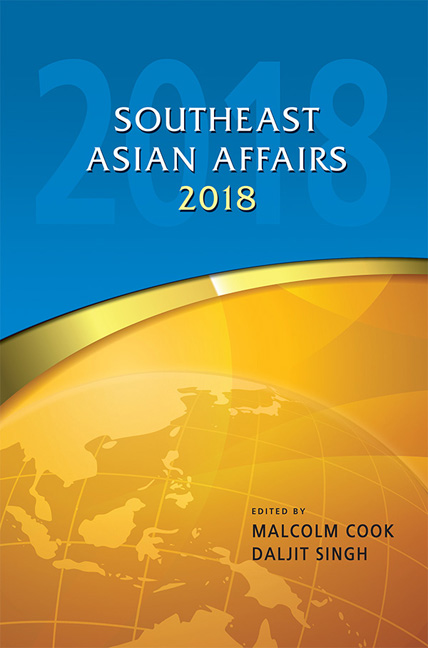Book contents
- Frontmatter
- Contents
- Introduction
- Acknowledgements
- THE REGION
- Notes on the Future of Southeast Asian Studies
- Southeast Asia on the Economic Front: Holding Steady, Bracing for Change
- Year One of the Trump Administration's Policy: Uncertainty and Continuity
- Southeast Asia in 2017: Grappling with Uncertainty
- BRUNEI DARUSSALAM
- CAMBODIA
- INDONESIA
- LAOS
- MALAYSIA
- MYANMAR
- THE PHILIPPINES
- SINGAPORE
- THAILAND
- TIMOR-LESTE
- VIETNAM
Southeast Asia in 2017: Grappling with Uncertainty
from THE REGION
Published online by Cambridge University Press: 08 June 2019
- Frontmatter
- Contents
- Introduction
- Acknowledgements
- THE REGION
- Notes on the Future of Southeast Asian Studies
- Southeast Asia on the Economic Front: Holding Steady, Bracing for Change
- Year One of the Trump Administration's Policy: Uncertainty and Continuity
- Southeast Asia in 2017: Grappling with Uncertainty
- BRUNEI DARUSSALAM
- CAMBODIA
- INDONESIA
- LAOS
- MALAYSIA
- MYANMAR
- THE PHILIPPINES
- SINGAPORE
- THAILAND
- TIMOR-LESTE
- VIETNAM
Summary
The year 2017 was a significant one for Southeast Asia in many ways. It was a milestone year, marking the fiftieth anniversary of ASEAN. Formed in the cauldron of the Cold War in August 1967, ASEAN has been credited with playing an instrumental role in fostering stability and security in the Southeast Asian region over the last five decades. Expressing this celebratory mood, the ASEAN calendar for the year was predictably inundated with events to commemorate the formation of the regional organization. In terms of economics, the countries of the region continued to grow at commendable rates, buoyed in no small part by increased domestic consumption and Chinese and Japanese investments.
Yet, the celebratory atmosphere could barely conceal the uncertainties and host of challenges that confront the region, and which manifested themselves in 2017. Foremost, at the geostrategic and geoeconomic level, was the election into office in the United States of Donald Trump, who, based on his campaign rhetoric, seemed to desire a fundamental overhaul of America's role in global affairs. On the other hand, China appeared to be relentlessly expanding its economic clout and influence in the region, with the Belt and Road Initiative (BRI) leading the way. Meanwhile, under Prime Minister Shinzo Abe, Japan appears to have awakened from its slumber and has both deepened and accelerated its own engagement of the region. Together with several other major challenges, such as humanitarian crises in Myanmar and Marawi, these developments not only made for an exacting year but also reflect the increasing complexity that has come to characterize the regional strategic and economic landscape and suggest potential challenges that need to be overcome in the years ahead.
Navigating Major Power Politics
The inauguration of the mercurial Donald Trump into the White House on 20 January ushered in something of a new era in regional affairs. A product of popular dissatisfaction among the American electorate, the Trump administration cast doubt over America's continued leadership of global affairs with its “America First” approach to international diplomacy. For the region, the early portents of change were not encouraging. One of Donald Trump's first acts as president was to withdraw the United States from the Trans-Pacific Partnership (TPP), which was painstakingly negotiated by his predecessor, Barack Obama.
- Type
- Chapter
- Information
- Southeast Asian Affairs 2018 , pp. 59 - 74Publisher: ISEAS–Yusof Ishak InstitutePrint publication year: 2018



